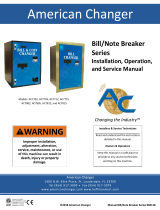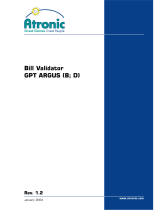
GBA Global Bill Acceptors GBA ST1 Operation Manual
Page 2 of 37 Astrosys International Ltd
September 2011
ST1 Operations Manual Rev 2.0
Contents
1.0 INTRODUCTION..............................................................................................................................3
2.0 PRODUCT INFORMATION...............................................................................................................4
2.1 General Specifications................................................................................................................4
2.2 Product Architecture..................................................................................................................4
2.3 Build Options..............................................................................................................................5
3.0 MECHANICAL CONFIGURATION.....................................................................................................8
3.1 Up stacker / Down stacker Configuration..................................................................................8
3.2 Horizontal Stacker......................................................................................................................9
3.3 Top Entry Stacker .....................................................................................................................10
3.4 Cassette Options ......................................................................................................................10
4.0 INTERFACE PROTOCOLS ...............................................................................................................13
4.1 NAMA MDB ..............................................................................................................................13
4.2 CCTALK
®
....................................................................................................................................13
4.3 USB ...........................................................................................................................................13
5.0 SOFTWARE CONFIGURATION.......................................................................................................15
5.1 On-board Push Button .............................................................................................................15
5.2 PC Based GBA Tools .................................................................................................................18
5.3 USB Mass Storage Device.........................................................................................................18
5.4 Software Configuration Options: .............................................................................................21
6.0 MECHANICAL INSTALLATION .......................................................................................................22
7.0 ELECTRICAL INTERFACE SPECIFICATION ......................................................................................23
7.1 Power .......................................................................................................................................23
7.2 Signal Interface.........................................................................................................................23
7.3 Low Power Mode .....................................................................................................................24
8.0 ELECTRICAL CONNECTIONS..........................................................................................................25
9.0 MAINTENANCE.............................................................................................................................27
9.1 Cleaning the Validator Note Path ............................................................................................27
9.2 Clearing a Note Jam .................................................................................................................28
9.3 Replacing Drive Belts................................................................................................................29
10.0 DIAGNOSTICS & TROUBLESHOOTING........................................................................................30
10.1 Diagnostics .............................................................................................................................30
10.2 Troubleshooting.....................................................................................................................30
10.3 Dimensional Drawings ...........................................................................................................30
Revision History..............................................................................................................................30
DISCLAIMER....................................................................................................................................30
REGIONAL OFFICES.........................................................................................................................30
























